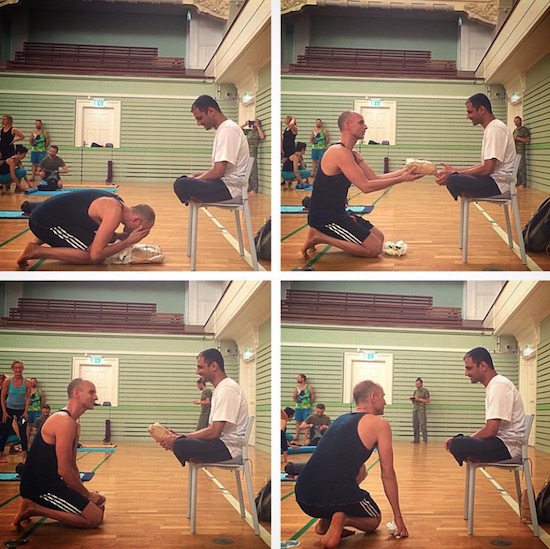
My first encounter with a community that would offer me unconditional help was when I began practicing Ashtanga yoga.
In the Buddhist tradition, such a community is called a sangha.
I didn’t initially grasp why being a part of such a community was so important—but then again, there are many things about this practice that I don’t fully understand. Perhaps this is simply a product of my lack of experience.
Eager to learn more about the sangha tradition, I turned to one of my teachers, Tim Feldmann. I find comfort in asking questions, seeing it as a way to voice my doubts and then feel at ease as I’m met with openness and patience. For me, it’s a small sign that I’m moving in the direction of deep discovery.
I trusted that Tim (and others who have been walking the yogic path longer than I have) would hold a deeper understanding of why sangha is an important—and maybe necessary—element of a daily yoga practice.
Here’s what he had to say:
Monica: What is sangha, and what role does it play in our attempt to live out this yogic path?
Tim: Sangha, the sanskrit word for community, is a supportive environment, a healing space. Let me quote my dear philosophy teacher from Mysore, India, Professor Rao. Rao talks about the four pillars of the spiritual path. To ensure success on an endeavor that goes beyond fame and fortune, to transcend the material, comfortable world and decide for whatever crazy reason to set onto a spiritual path, you will need these four principles as your friend.
And one of these is a supportive community, or as you say, “sangha.” To set yourself up for long-term success—not just “hey look at me, I can do this asana too!”—you need a community to practice within because a perspective rises there which is not easily found when walking this jungle of life alone.
So, community is one pillar. And you need to put forth an honest effort, because that is the central piece in this matrix—our personal devotion and effort. You also need a teacher who has walked the path and knows the ins and outs, because without it, you can so easily get lost along the way. Finally you need time to do its job: to let things settle, to make the grape juice into wholesome wine.
These are the classic four pillars that lead to a successful spiritual path: an earnest practice, a selfless teacher, the effect of time, and the support of sangha.
Monica: Why can’t we just have a daily practice in our homes, without others being involved?
Tim: We can, but without a community, without sangha and someone to share our ups and downs with, practice can get quite lonely and confusing. When we have a place to go to for support, understanding, and acceptance, a place where we can be vulnerable and weak without being judged, we grow more easily.
When we participate in a community where we find awareness, harmony, and love, we willingly let go of our protective gear because we feel supported and understood. All this must be present in a sangha—the support must feel tangible. If you find yourself in a sangha where these golden nuggets are not there, find another one! (He laughs).
We go to the sangha because we feel we need some help. We need help to cultivate something deeper in ourselves than the rest of society can give us, can allow us. We go to the sangha to cultivate these revitalizing, life-giving seeds, and then we go back to society to infuse it everywhere and give to everyone.
When we practice on our own, it’s hard to define whether we are making actual progress or whether we are digging ourselves deeper into the trenches of habits.
It is said that “progress mostly doesn’t feel like progress,” so we often need some honest sounding board to work up against to help us not lose our direction. A teacher and a community, coupled with deep inquiry into the texts which describe the foundations behind our practice, together form a powerful tool to ensure we head in a useful direction and not into somatic or intellectual masturbation without realizing it.
Monica: How has being part of a sangha personally helped you in your practice?
Tim: A sangha is a place where we are being asked to be accountable and honest with who we are. And at the same time, we can find the courage we need to be able to face ourselves. To not only be honest with ourselves but with the rest of society, too. We find the support in others to go through that process.
It’s the process of self-realization. We confront the good stuff and the bad stuff. We admit to equal parts support and challenge. Beyond the yoga practice itself, the sangha is a place where we can have a second chance, where we can come to forgive ourselves and the people we love. We get a second chance to pursue the subtle and poetic parts of ourselves that there isn’t always space for in our everyday, in society in general.
When everything works well, I happily practice at home. When I find myself a little lazy or less motivated to move my body in and out of these asanas, when practice feels confrontational beyond comfortable, that’s when I go to practice with my community. I get help with my back drops (maybe more than I like—hahaha!), I get energy from my fellow practitioners and a reason to stay on my mat. That would be one reason of many.
Every year, I go to India for the same reason: to subject myself to the deep learning that goes beyond comfort or my preferred momentary state of being, like, “Oh, I’d like to sleep a little longer,” or “I think I’ll do primary again today cause my body feels stiff.” When I go and place my body under a teacher, when I submit myself like that, I get the rare gift of losing myself, of getting away from myself and all my petty issues and concerns. I am always so neurotically self-conscious but there I get to just be whatever that moments brings and not whatever I can think up.
I suppose you could say that sangha, just as with yoga, helps me transcend myself. I get a moment of peace just from being with myself. For me, there is nothing I’d rather have in this world.
Monica: How does a sangha help someone going through the inevitable difficulties in this life?
Tim: It helps because of the sharing and happiness that goes on within a sangha. It is possible to be vulnerable. It is possible to connect to all sides of ourselves, to connect with others, and therefore to connect to society—and by doing so, to begin to rebuild our connection to the world.
There’s a joke that goes, “Do you ever have the feeling that the world is a tuxedo, and you’re a pair of brown shoes?” Now, I don’t know about you, but don’t we all feel like that sometimes? A sangha is a place that gives us the allowance to acknowledge that deeply ingrained pain and come to terms with it. So we go to practice—with practice defined as an action or activity that leads to positive transformation.
We get to know ourselves and understand ourselves. We gradually rebuild a connection to ourselves and therefore a connection to everyone around us. And when that begins to take root, when we begin to experience and stand strong in our own personal bedrock, we inevitably create more ease, pleasure, and usefulness with everyone we meet. We feel it. They feel it. We start to have more satisfying relationships.
All that we take from our sangha back into society begins to heal society. We go further and begin to work on rebuilding what has been lost and what is missing in society. And it all starts with practice, with committing to that action or effort which sets the seed for inner growth and knowing. Now of course, all that can be practiced anywhere, but a sangha is focused on creating an environment congruent with the possibility for all this to happen. So we benefit when we take part—or as the Buddhists say, “Take refuge in your sangha.” That’s what it’s all about.
Monica: So if I want to experience all that, how do I actively participate in a sangha?
Tim: Ha! That’s a good question! Which skills should I already embody to be part of a sangha? First of all, you need no skills, you just come. The sangha is exactly there to help all of us individuals cultivate that spirited, human type of living. Second, I suppose that if you want a really full and deeply nurturing experience when being with other people, then it probably follows that good old thing of what you give is what you get.
I’d say putting yourself into the community fully, opening yourself up to the people there, being of help and service to the people around you—all the people—then we slowly begin to feel that love burn back toward us. The heat, the warmth from that fire of the heart will reach back to us somehow.
But what is a good way to part take in a sangha, in your chosen community? Well, show up and be available to whomever approaches you or whatever happens without judgment—and instead just experience.
Listen more than talk. Allow for the unexpected. Cultivate a proactive stance to being of help. Practice for the person next to you. Voice your concerns and interests to the people in charge. Lend an ear when appropriate.
But first and foremost just show up. And if that is easy, then yes—take active part.
~
~
Author: Monica Arellano
Image: Tim Feldmann
Editor: Callie Rushton
Copy Editor: Nicole Cameron
Social Editor: Waylon Lewis








Read 0 comments and reply